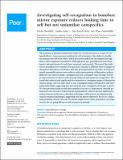Files in this item
Investigating self-recognition in bonobos : mirror exposure reduces looking time to self but not unfamiliar conspecifics
Item metadata
| dc.contributor.author | Shorland, Gladez | |
| dc.contributor.author | Genty, Emilie | |
| dc.contributor.author | Guéry, Jean-Pascal | |
| dc.contributor.author | Zuberbühler, Klaus | |
| dc.date.accessioned | 2020-09-09T11:30:05Z | |
| dc.date.available | 2020-09-09T11:30:05Z | |
| dc.date.issued | 2020-08-28 | |
| dc.identifier | 269224823 | |
| dc.identifier | f1fd229c-6183-4c5a-990e-a966e01cc339 | |
| dc.identifier | 000563710000003 | |
| dc.identifier | 85091523061 | |
| dc.identifier.citation | Shorland , G , Genty , E , Guéry , J-P & Zuberbühler , K 2020 , ' Investigating self-recognition in bonobos : mirror exposure reduces looking time to self but not unfamiliar conspecifics ' , PeerJ , vol. 8 , e9685 . https://doi.org/10.7717/peerj.9685 | en |
| dc.identifier.issn | 2167-8359 | |
| dc.identifier.other | ORCID: /0000-0001-8378-088X/work/80257438 | |
| dc.identifier.uri | https://hdl.handle.net/10023/20592 | |
| dc.description | The research leading to these results has received funding from the European Research Council under the European Union's Seventh Framework Programme (FP7/2007-2013)/ERC grant agreement no. 283871 and the Swiss National Science Foundation (Social learning in primate communication: 31003A_166458 / Coordinating joint action in apes: Testing the boundaries of the human interaction engine: CR31I3_159655). | en |
| dc.description.abstract | The question of whether animals have some sort ofself-awareness is a topic of continued debate. A necessary precondition forself-awareness is the ability to visually discriminate the self from others,which has traditionally been investigated through mirror self-recognition experiments.Although great apes generally pass such experiments, interpretations of resultshave remained controversial. The aim of this study was to investigate howbonobos (Pan paniscus) respond todifferent types of images of themselves and others, both before and afterprolonged mirror exposure. We first presented presumably mirror-naive subjectswith representations of themselves in three different ways (mirror image,contingent and non-contingent video footage) as well as representations ofothers (video footage of known and unknown conspecifics). We found thatsubjects paid significantly less attention to contingent images of themselves(mirror image, video footage) than to non-contingent images of themselves andunfamiliar individuals, suggesting they perceived the non-contingent self-imageas novel. We then provided subjects with three months of access to a largemirror centrally positioned in the enclosure. Following this manipulation,subjects showed significantly reduced interest in the non-contingentself-images, while interest in unknown individuals remained unchanged,suggesting that the mirror experience has led to a fuller understanding oftheir own self. We discuss implications of this preliminary investigation forthe on-going debate on self-awareness in animals. | |
| dc.format.extent | 19 | |
| dc.format.extent | 1129687 | |
| dc.language.iso | eng | |
| dc.relation.ispartof | PeerJ | en |
| dc.subject | Delayaed self-recognition | en |
| dc.subject | Mental representation | en |
| dc.subject | Looking time | en |
| dc.subject | Pan paniscus | en |
| dc.subject | Self-awareness | en |
| dc.subject | Primate cognition | en |
| dc.subject | Social intelligence | en |
| dc.subject | Intelligence | en |
| dc.subject | Theory of mind | en |
| dc.subject | Evolution of cognition | en |
| dc.subject | BF Psychology | en |
| dc.subject | DAS | en |
| dc.subject.lcc | BF | en |
| dc.title | Investigating self-recognition in bonobos : mirror exposure reduces looking time to self but not unfamiliar conspecifics | en |
| dc.type | Journal article | en |
| dc.contributor.institution | University of St Andrews. Institute of Behavioural and Neural Sciences | en |
| dc.contributor.institution | University of St Andrews. Centre for Social Learning & Cognitive Evolution | en |
| dc.contributor.institution | University of St Andrews. School of Psychology and Neuroscience | en |
| dc.identifier.doi | https://doi.org/10.7717/peerj.9685 | |
| dc.description.status | Peer reviewed | en |
| dc.date.embargoedUntil | 2020-08-28 | |
| dc.identifier.url | https://peerj.com/articles/9685/#supplemental-information | en |
This item appears in the following Collection(s)
Items in the St Andrews Research Repository are protected by copyright, with all rights reserved, unless otherwise indicated.

